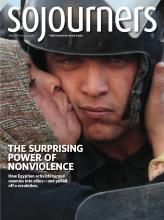Here are nine "best practices" used by organizers that helped lead to a successful nonviolent campaign in Egypt:
1. Clear Goals. The organizers clearly identified their goals early on. They were posted in Tahrir Square for everyone to see. The organizers stuck to these goals, even when pressured to settle for less.
2. Broad Base. The organizers built a wide coalition across Egyptian civil society, including the whole political spectrum: Muslims and Christians; farmers, students, and labor; the poor and the wealthy.
3. Positive relations with the army. The organizers actively and strategically cultivated a positive relationship with the army. After the police withdrew, organizers brought the soldiers tea, flowers, and lots of kisses. This was based on the organizers' understanding of nonviolence, as well as their study of recent successful nonviolent revolutions, during which the army either did not intervene or actively supported the change, such as in Serbia.
4. Women. They created a safe place for women. The organizers encouraged and welcomed the participation of women and children, something that is crucial for the security of everyone. They made it clear that the sexual harassment of women was not allowed (this is something which is a big problem in Cairo), thereby making it safer for women to participate.
5. Cultural Enjoyment. They made the demonstrations fun! Inside Tahrir Square were a number of stages -- one had speakers, at another someone led chants. There were stages with musicians, singing, and comedy acts. They offered face painting and lots of art, especially cartoons for posters. Organizers created a sense of community -- of the "new Egypt" -- inside Tahrir Square.
Read the Full Article
